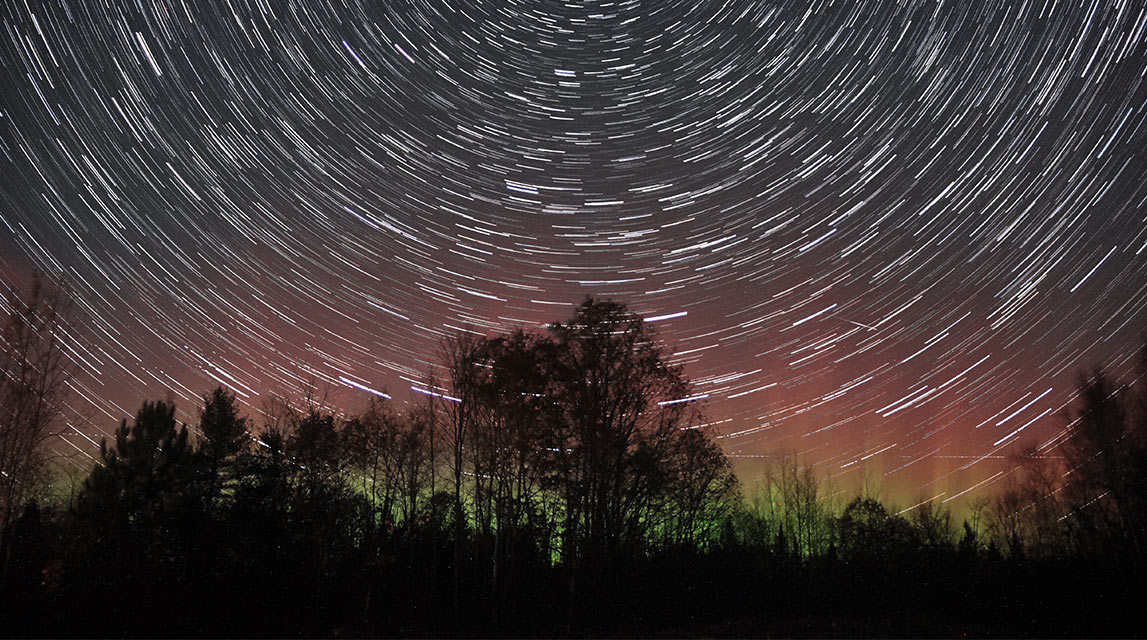
Sony NEX-5R, ƒ/3.5, 18.0 mm, ISO 3200
June is another slow month for meteor activity. There are no major showers active in June and only the Anthelion source can be counted on for continuous activity. Even the Anthelion radiant is located so far south this time of year that rates rarely exceed 2 per hour as seen from the northern hemisphere. Sporadic rates continue to remain slow as seen from the mid-northern hemisphere (45 N). As seen from the southern tropics (25 S) sporadic rates continue to be strong this month.
During this period the moon will reach it’s last quarter phase on Wednesday June 6th. At that time the moon will be located 90 degrees west of the sun and will rise between 0100 and 0200 local summer time (LST) for observers located at mid-northern latitudes. This weekend the waning gibbous moon will rise during the late evening hours, spoiling viewing conditions with bright moonlight the remainder of the night. The estimated total hourly meteor rates for evening observers this week is 3 as seen from mid-northern latitude (45N) and 4 from the southern tropics (25S). For morning observers the estimated total hourly rates should be near 7 as seen from mid-northern latitudes (45N) and 10 from the southern tropics (25S). The actual rates will also depend on factors such as personal light and motion perception, local weather conditions, alertness and experience in watching meteor activity. Rates are reduced during the morning hours during this period due to moonlight. Note that the hourly rates listed below are estimates as viewed from dark sky sites away from urban light sources. Observers viewing from urban areas will see less activity as only the brighter meteors will be visible from such locations.
The radiant (the area of the sky where meteors appear to shoot from) positions and rates listed below are exact for Saturday night/Sunday morning June 02/03. These positions do not change greatly day to day so the listed coordinates may be used during this entire period. Most star atlases (available at science stores and planetariums) will provide maps with grid lines of the celestial coordinates so that you may find out exactly where these positions are located in the sky. A planisphere or computer planetarium program is also useful in showing the sky at any time of night on any date of the year. Activity from each radiant is best seen when it is positioned highest in the sky, either due north or south along the meridian, depending on your latitude. It must be remembered that meteor activity is rarely seen at the radiant position. Rather they shoot outwards from the radiant so it is best to center your field of view so that the radiant lies near the edge and not the center. Viewing there will allow you to easily trace the path of each meteor back to the radiant (if it is a shower member) or in another direction if it is a sporadic. Meteor activity is not seen from radiants that are located far below the horizon. The positions below are listed in a west to east manner in order of right ascension (celestial longitude). The positions listed first are located further west therefore are accessible earlier in the night while those listed further down the list rise later in the night.
These sources of meteoric activity are expected to be active this week.
The tau Herculids (TAH) may be active from a radiant located near 15:16 (229) +40. This position lies in northern Bootis, 3 degrees east of the 4th magnitude star known as Nekkar (beta Bootis). This area of the sky is best placed as soon as it becomes dark. No activity is expected from this source this year but one might monitor this area of the sky just in case. These meteors are best suited for viewing from the northern hemisphere as the radiant is located low in the sky for observers situated in the southern hemisphere. With an entry velocity of 15 km/sec., the average tau Herculid meteor would be of very slow velocity.
The center of the large Anthelion (ANT) radiant is currently located at 17:40 (265) -23. This position lies on the Ophiuchus/Sagittarius border, 5 degrees northeast of the 3rd magnitude star known as theta Ophiuchi. Due to the large size of this radiant, Anthelion activity may also appear from the nearby constellations of western Sagittarius, northern Scorpius, and southern Serpens Cauda as well as southern Ophiuchus . This radiant is best placed near 0200 LST, when it lies on the meridian and is located highest in the sky. Hourly rates at this time should be near 1 as seen from mid-northern latitudes and 2 as seen from tropical southern latitudes. With an entry velocity of 30 km/sec., the average Anthelion meteor would be of slow velocity.
The first members of the Northern June Aquilids (NZC) may be seen this week from a radiant located at 18:52 (283) -13. This area of the sky is located in the dim constellation of Scutum. An easy way to locate this position is to find the bright planet Saturn in northern Sagittarius. The radiant lie approximately 8 degrees northeast of Saturn. This radiant is best placed near 0300 LST, when it lies on the meridian and is located highest in the sky. With the night of maximum nearly a month away, hourly rates at this time will be less than 1 no matter your location. With an entry velocity of 38 km/sec., the average meteor from this source would be of medium-slow velocity.
The June mu Cassiopeiids (JMC) were discovered by Dr, Peter Brown and associates using data from the Canadian Meteor Orbit Radar (CMOR) installation. These meteors are active from May 18-June 15, with maximum activity occurring on June 7th. The radiant position currently lies at 00:48 (012) +54. This area of the sky lies in southeastern Cassiopeia, 3 degrees south of the 2nd magnitude star known as Shedar (alpha Cassiopeiae). These meteors are best seen near during the last dark hour of the night when the radiant lies highest in a dark sky. These meteors are better seen from the northern hemisphere where the radiant rises higher into the sky before the start of morning twilight. Hourly rates are expected to be less than 1. With an entry velocity of 42 kilometers per second, a majority of these meteors will appear to move with medium velocities.
The Daytime Arietids (ARI) are a strong shower but difficult to view due to the proximity of the radiant to the sun. These meteors are active from May 22 through June 24 with a peak on June 7. The radiant is currently located at 02:44 (041) +24. This area of the sky is located in central Aries, 6 degrees east of the position occupied by the 2nd magnitude star known as Hamal (alpha Arietis). The best time to view this activity is during the hour before the start of morning twilight, when the radiant lies highest in a dark sky. With the radiant low in the east it would be best to face halfway up in the sky in a northeast direction. With an entry velocity of 42 kilometers per second, these meteors will appear to move at a medium velocity.
As seen from the mid-northern hemisphere (45N) one would expect to see approximately 5 sporadic meteors per hour during the last hour before dawn as seen from rural observing sites. Evening rates would be near 2 per hour. As seen from the tropical southern latitudes (25S), morning rates would be near 8 per hour as seen from rural observing sites and 3 per hour during the evening hours. Locations between these two extremes would see activity between the listed figures. Morning rates during this period are reduced due to moonlight.
The list below offers the information from above in tabular form. Rates and positions are exact for Saturday night/Sunday morning except where noted in the shower descriptions.
| SHOWER | DATE OF MAXIMUM ACTIVITY | CELESTIAL POSITION | ENTRY VELOCITY | CULMINATION | HOURLY RATE | CLASS |
| RA (RA in Deg.) DEC | Km/Sec | Local Summer Time | North-South | |||
| tau Herculids (TAH) | Jun 02 | 15:16 (229) +40 | 15 | 00:00 | <1 – <1 | III |
| Anthelion (ANT) | – | 17:40 (265) -23 | 30 | 02:00 | 1 – 2 | II |
| Northern June Aquilids (NZC) | Jul 03 | 18:52 (283) -13 | 38 | 03:00 | <1 – <1 | IV |
| June mu Cassiopeiids (JMC) | Jun 07 | 00:48 (012) +54 | 42 | 09:00 | <1 – <1 | IV |
| Daytime Arietids (ARI) | Jun 07 | 02:44 (041) +24 | 41 | 11:00 | 1 – <1 | IV |


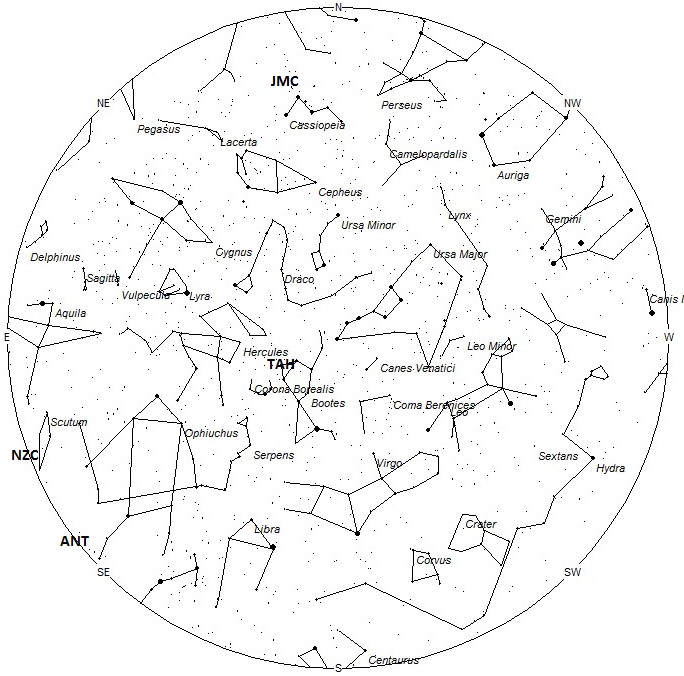
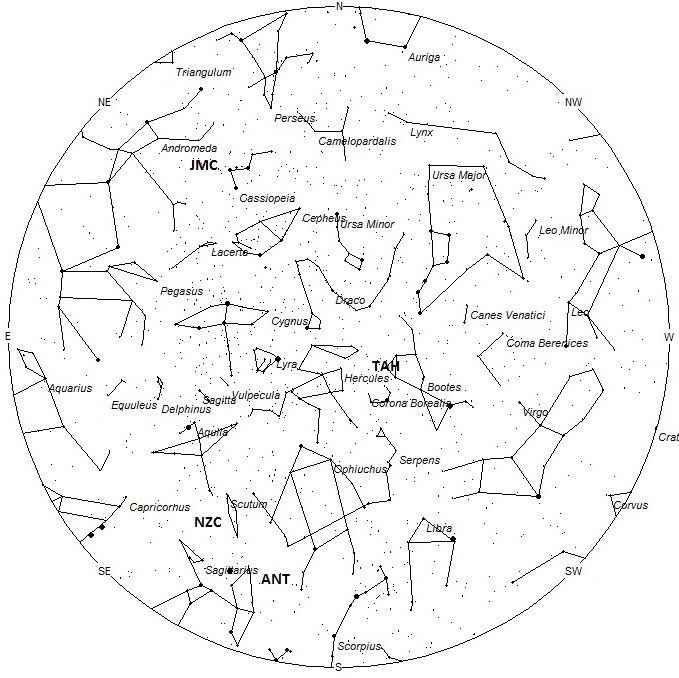
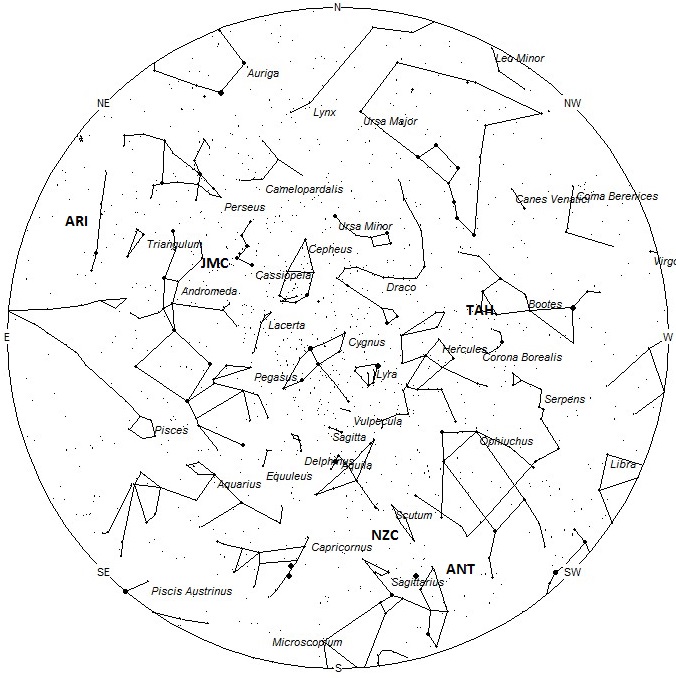

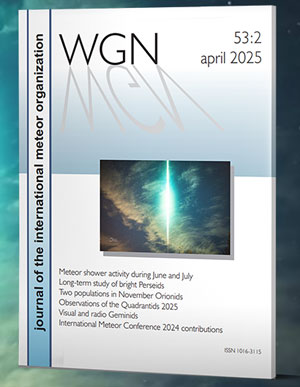
 You saw something bright and fast? Like a huge shooting star? Report it: it may be a fireball.
You saw something bright and fast? Like a huge shooting star? Report it: it may be a fireball.  You counted meteors last night? Share your results with us!
You counted meteors last night? Share your results with us!  You took a photo of a meteor or fireball? You have a screenshot of your cam? Share it with us!
You took a photo of a meteor or fireball? You have a screenshot of your cam? Share it with us!  You caught a meteor or fireball on video? Share your video with us!
You caught a meteor or fireball on video? Share your video with us!